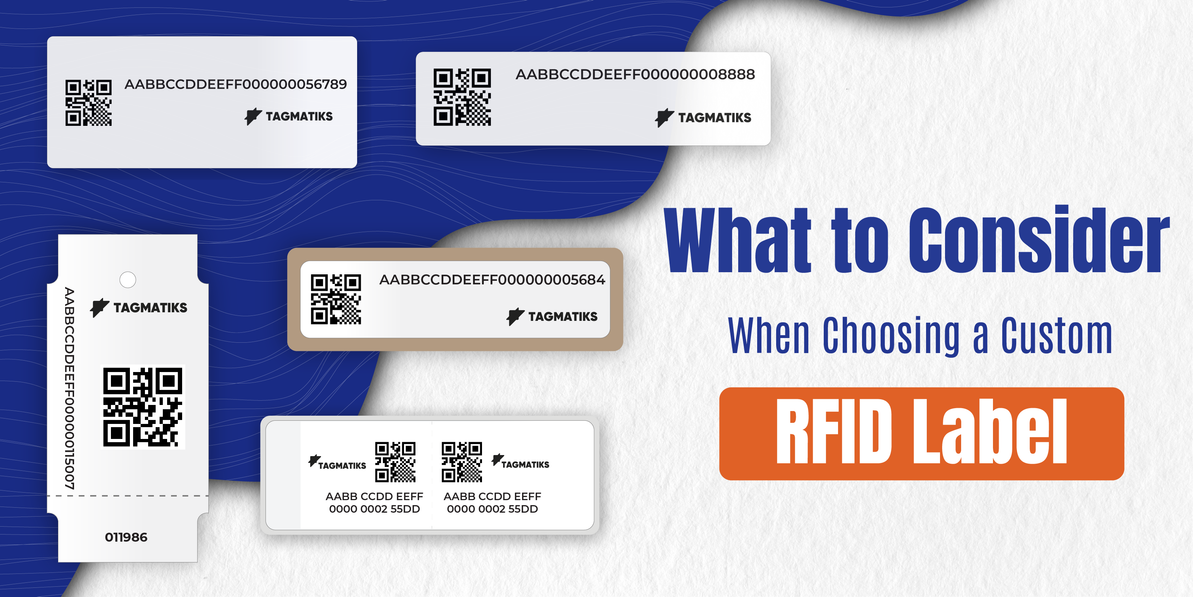What to Consider When Choosing a Custom RFID Label
Radio-Frequency Identification (RFID) technology has revolutionized the way businesses track and manage assets. From inventory management to supply chain logistics, RFID labels provide a seamless and efficient solution for tracking and monitoring items. However, selecting the right custom RFID label for your needs can be challenging, given the myriad of options available. This blog will guide you through the essential factors to consider when choosing a custom RFID label to ensure optimal performance and return on investment.
Application Requirements
The first step in choosing an RFID label is understanding your specific application requirements. Consider the following questions:
- What type of assets will you be tracking (Metal, Non-Metal)?
- What is the environment in which the RFID labels will be used (e.g., indoor, outdoor, extreme temperatures)?
- What is the required read range?
- Do you need the labels to withstand harsh conditions such as chemicals, moisture, or abrasion?
Understanding these requirements will help narrow down the choices and ensure the selected RFID labels meet your operational needs.
Label Material and Durability
The material of the RFID label plays a crucial role in its durability and performance. Common materials include paper, and polyester. Each material has its strengths and weaknesses:
- Paper Labels: Cost-effective and suitable for indoor use where there is minimal exposure to harsh conditions.
- Polyester Labels: Durable and resistant to chemicals, moisture, and abrasion, making them ideal for industrial environments.
Choose a material that aligns with your durability requirements and environmental conditions.
Chip and Antenna Selection
The RFID chip and antenna are the core components of an RFID label. The choice of chip and RFID antenna will impact the label's performance, including read range, data capacity, and compatibility with RFID readers. Consider the following:
- Chip Memory: Depending on your application, you may need a chip with higher memory capacity to store more data.
- Read Range: The RFID antenna design and size influence the read range. Ensure the antenna can achieve the required read distance for your application.
- Frequency: RFID systems operate at different frequencies (Low Frequency (LF), High Frequency (HF), Ultra-High Frequency (UHF), and Microwave). Choose the frequency that matches your existing infrastructure and application needs.
Adhesive Type
The adhesive on the RFID label is crucial for ensuring it stays affixed to the asset throughout its lifecycle. Consider the surface material of the asset and the environmental conditions to select the appropriate adhesive:
- Permanent Adhesive: Ideal for long-term applications where the label needs to stay in place permanently.
- Removable Adhesive: Suitable for temporary applications where the label may need to be removed without leaving residue.
- Specialty Adhesive: For challenging surfaces such as metal, glass, or textured surfaces, specialty adhesives ensure strong adhesion.
Customization Options
Custom RFID labels can be tailored to meet specific branding or operational needs. Consider the following customization options:
- Printing and Branding: Custom printing with logos, barcodes, or other information can enhance branding and facilitate easy identification.
- Shape and Size: Custom shapes and sizes can be designed to fit specific assets or requirements.
- Special Features: Additional features such as tamper-evident designs, dual-frequency capabilities, or embedded sensors can enhance functionality.
Compliance and Standards
Ensure that the custom RFID labels comply with relevant industry standards and regulations. This is especially important in industries such as healthcare, logistics, and retail, where specific compliance requirements must be met. Common standards include:
- ISO/IEC 18000-6C (EPC Class 1 Gen 2): For UHF RFID systems.
Cost and Scalability
Budget considerations are always important. Evaluate the cost of custom RFID labels and balance it against the performance and durability required for your application. Additionally, consider scalability:
- Volume Discounts: Larger orders may benefit from volume discounts, reducing the overall cost per label.
- Future Expansion: Ensure the RFID solution can scale with your business needs, accommodating future growth and increased asset tracking requirements.
Vendor Expertise and Support
Choosing the right vendor is as important as selecting the right RFID label. Look for vendors with proven expertise in RFID technology and a track record of successful implementations. Evaluate the level of support they provide, including:
- Technical Support: Availability of technical assistance for troubleshooting and implementation.
- Customization Capabilities: Ability to design and produce custom RFID labels tailored to your specific needs.
- After-Sales Service: Support for maintenance and potential future upgrades.
Conclusion
Selecting the right custom RFID label is a critical step in ensuring the success of your RFID implementation. By considering the application requirements, label material, chip and antenna selection, adhesive type, customization options, compliance, cost, and vendor expertise, you can make an informed decision that aligns with your operational needs and business goals. Investing the time and effort to choose the right RFID label will pay off in improved efficiency, accuracy, and overall asset management.
Remember, RFID technology is not one-size-fits-all, and the right solution for one business may not be suitable for another. Take the time to evaluate your specific needs and work with experienced vendors to create a tailored solution that maximizes the benefits of RFID technology.
Recent Posts
-
RFID Gate Portals in Retail and Warehouses
The landscape of retail and warehouse operations is undergoing a profound transformation, moving awa …Dec 18th 2025 -
Why Add RFID to Your Labeling Strategy in 2026
In 2026, the global supply chain is undergoing a seismic transformation. From omnichannel retail to …Dec 11th 2025 -
Zebra Handheld RFID Readers for Retail Efficiency
In the dynamic world of retail, where inventory accuracy, customer experience, and operational effic …Nov 28th 2025




